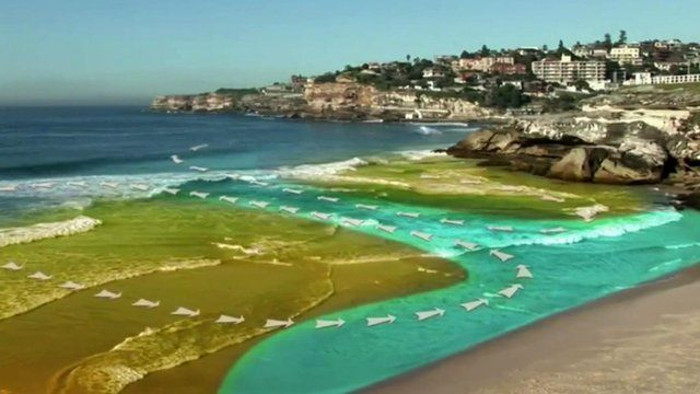The deadly vortex lurks deep beneath the still, silent water
Offshore flow is a common phenomenon in beaches. This is the main cause of fatal accidents for tourists when going to the beach.
What is offshore flow?
The offshore flow is a strong stream of water flowing from the shore towards the sea. The waves will hit and bring sea water to shore, but when the sea water is continuously brought to the shore, they gather into a stream going back to the sea. This sea-going seawater is called a rip (or rip current). Offshore currents can drag people away from the coast at speeds greater than an Olympic athlete - in 1 minute it may suddenly sweep away about 100m.

Proficient people believe that the swirling waters often hide deep below where the water is quiet and dark green.
A place with regular whirlpools looks like a safe place for swimmers. Since there are no big waves, many people are not alert.
Most people do not know how to recognize the place where there is a great possibility of offshore currents ( whirlpools) or do not know what they should do when caught in this dangerous situation. Those who are proficient say that the vortex often hidden deep below where the water is quiet and dark green.
This reverse water flow can remain stable throughout the month / year. However, they can also constantly change every few hours. On some beaches, this reverse water flow does not go towards the sea but runs along the coast.
How to identify the offshore flow
Before entering the sea, you should spend about 5-10 minutes to identify the offshore flow with the following characteristics:
- There is a darker color because the place is deeper.
- There is a quieter water surface, usually with smaller waves.
- Sometimes debris / bubbles can be seen floating on the surface of the river and drifting out to sea.
 In fact, we can identify this reverse flow with the naked eye
In fact, we can identify this reverse flow with the naked eye
The secret to getting out of the offshore flow
The Rip Current may suddenly appear at 0.3-0.6m / sec and there will usually be no sign of recognition. But once caught in and to be swept away, this flow can quickly accelerate, reaching 1-2.5 meters per second, at which point no one can escape this vortex of death.

When swirling, let me drift along the water and signal for help.
When you have a vortex of death, try to do the following:
- Do not panic. This is the most important thing. Try to stay calm. The withdrawal line will not draw you to the bottom but only take you away from the shore. And usually instantaneous flow takes you away from the shore about 30 m.
- Do not swim upstream. Do not try to swim upstream from the shore because most cases drown because of upstream, not because of being sucked down but because the victims are too panicked and try to swim upstream. This is impossible, because with the speed of 2.5m / s, even if it is Michael Phelps - the American fisherman will be exhausted and drown.
- Swim across the coast. Instead of trying to swim upstream, find a way to swim parallel to the coast, which is perpendicular to the flow. After escaping the vortex, swim across the corner and head towards the shore.
- Follow the flow. For those who are exhausted, not physically fit to escape the reverse line, float yourself along the line. When the flow is reversed, try to swim parallel to the coast or signal to rescue or nearby people to rescue.
Video introduction about rip current and how to prevent:
- Fire cannons turn into vortex columns when touching the river
- The fish community is forgotten in the deep sea
- America launches 'The unbeatable eagle' is the new version of the Su-35S that is able to fight against Russia
- The sun was silent
- Over 3,000 deadly holes around the Dead Sea
- The comet is found deep in the solar system
- The earth is gradually drying up because it is swallowing the ocean itself
- Whirlpools rise to the sky in the Mexican sea
- Zika virus lurks deep in the body, difficult to kill
- Mars' southernmost ice region is very deep and wide
- The robot dug deep under water
- The mysterious 'death worm' can kill people without biting
 'Fine laughs' - Scary and painful torture in ancient times
'Fine laughs' - Scary and painful torture in ancient times The sequence of numbers 142857 of the Egyptian pyramids is known as the strangest number in the world - Why?
The sequence of numbers 142857 of the Egyptian pyramids is known as the strangest number in the world - Why? Miracle behind the world's largest stone Buddha statue
Miracle behind the world's largest stone Buddha statue What is alum?
What is alum?